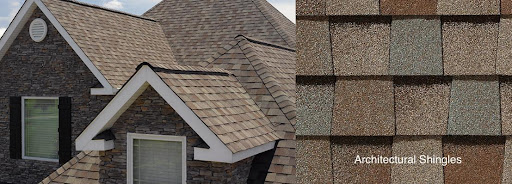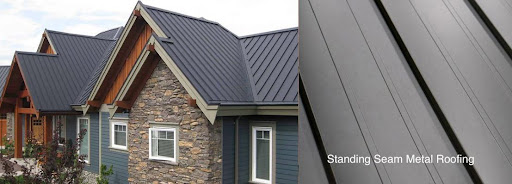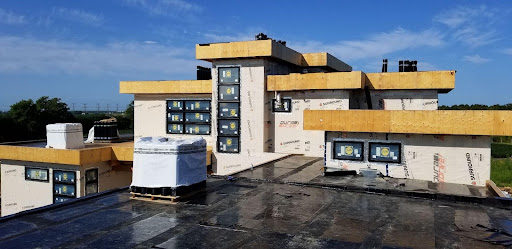Installing or replacing a roof is, at best, a major hassle. Homeowners dread it for this reason, plus that often eye-watering price tag. Few know about the different roofing materials available that help cut costs, or simply create a home better suited to your style.
The options homeowners have regarding the look, price, and durability of their roofs are entirely customizable. There are several common roofing materials you should consider for your home, all with unique characteristics and aesthetics.
Flat Roofing Materials
While flat roofing is more common on the industrial/commercial side of things, there have been more instances of flat roofing in residential homes. The style and convenience of a flat roof are attractive for homeowners.
If you’re designing your home, the option to build a blend of both a pitched and a flat roof can create an architectural delight. The most common types of material used in flat roofing are:
Bitumen, roofing felt, stone and gravel
The main ingredients of the BUR or Built-Up Roof are bitumen, roofing felt, and stone and gravel. It’s the oldest form of flat roofing dating back over 100 years.
Modified bitumen
Although the components are almost identical to bitumen, this should be considered a separate roofing material. A modified bitumen roof uses single-ply sheets reinforced with polymer. These are then heated up to form a seamless layer of bitumen for enhanced insulation, stronger durability, and more leak resistance.
EPMD (ethylene propylene diene monomer)
This is a type of rubber used on low-pitched roofs. This material comes in rolls and is installed by adhesive. It can also be ballasted or mechanically attached.
TPO (Thermoplastic Polyolefin)
This particular compound was first used for roofing in the late 1980s. It is often preferred over its EPMD counterpart because it doesn’t contain chlorine and is considered greener with more potential for enhanced performance.
PVC (polyvinyl chloride)
This polymer of plastic takes third place as the third most widely produced. It’s a single-ply roofing membrane and is known for its durability and cost-effectiveness.
Choosing between the various types of roofing material for flat roofs can be difficult without doing your homework or consulting flat roofing contractors. The issues that become the most prevalent in making a decision will depend on the pitch, budget, and climate your home or business is located.

Asphalt Shingles
At the top of the “most common” list are asphalt shingles. They rule the roofing world due to their low cost and decent durability. Color options and finishes are also customizable with this material, though colors are likely to fade with sun exposure.
There are three different categories within the genre of asphalt shingles: 3-tab, architectural, and luxury. The cost and durability increase from 3-tab to luxury, giving even further customization power. Architectural shingles are the most common form of asphalt shingling. Being a bit more durable than 3-tab and not much pricier, homeowners can enjoy the quality of this option without racking up a massive bill.
Metal Roofing
Like asphalt roofing, there are different options for metal roofing. Here we want to mention the most popular two, which are standing seam metal and metal shingles.
Standing Seam Metal
The most common option is standing seam sheets of metal that connect under a top seam. Aluminum or steel is generally used to craft these roofs.
Metal roofs are fireproof and highly wind-resistant, making them a great option for areas with tumultuous climates. Metal is much pricier than asphalt shingles, but the benefits it boasts can be quite persuasive.
Metal Shingles
Some homeowners prefer to keep the benefits of metal roofs but not the aesthetic. Metal shingles mimic the look of asphalt shingles, coated with a thin layer of mineral granules to lose their metallic look. This option can be slightly cheaper than standing seam, and with a myriad of finish options, the final aesthetic is entirely up to you.
Wood Shingles
Cedar shingles are one of the prettiest roofing materials available. Homeowners appreciate the unique look of wood shingles, customized by choosing hand-milled pieces or factory-made. Wood shingles are thinner and cheaper, while wood slates are thicker pieces of split wood, often more rugged in appearance. Wooden roofs don’t come with a warranty as they are made of natural materials. They typically don’t last as long as other roofs, especially in wetter climates.
The cost of wood shingles compared to their durability and efficiency is a bit daunting. But if you live somewhere dry and want a luxury look, this is the option for you.

Composite Roofing
Composite roofing materials are made from synthetic or recycled materials. They are created from mixtures of plastic and rubber or engineered out of polymer. The unique aspect of this material is its customizability.
If you’d like your roof to look like wood, for example, composite manufacturers will deliver. Composite roofs also mimic slate roofing, asphalt, and clay. This roofing material is designed to be durable and cut back on some of the weight limitations found in heavier materials like slate.
Concrete Roofing
Concrete tiles work great in high-wind areas or climates with a lot of sun exposure and heat. Their heaviness prevents tiles from blowing away, and hardy concrete stands up well to the power of the sun in arid climates. Clay tiles offer similar advantages, but the cheaper costs of concrete tiles make them slightly more common.
Different hues and finishes are then added to achieve your desired look. The tiles themselves can be shaped to mimic slate or other materials, offering more options to customize.
While this material is expensive, you’ll get at least 50 years of life out of a roof tiled with concrete.
Slate Roofing
Slate tiles reign in the durability department. Slate comes from mines, where it is then cut into small squares. These heavy pieces of slate tile are installed one square at a time. The laborious installation process and the expertise required for success add a high cost to the already expensive material, making slate roofs one of the priciest roofing options. With that price, though, comes extreme durability and a stunning aesthetic. A slate roof will likely outlive you and even your grandkids–meaning your investment is a true one-and-done deal.






